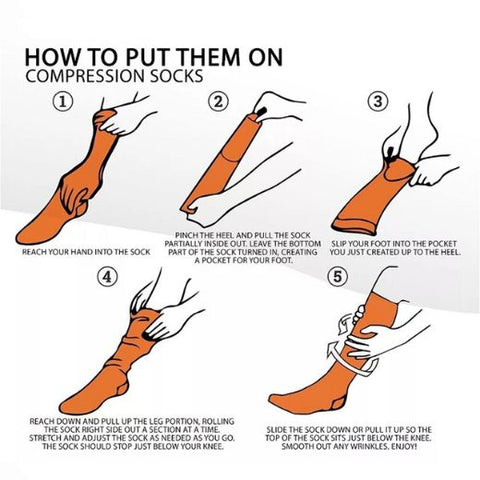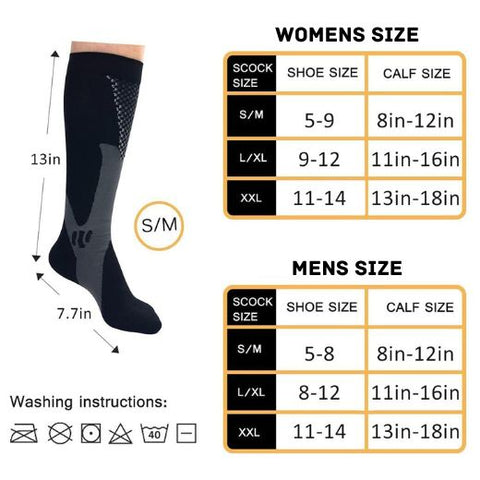Compression Socks For Nurses
-
Plus Size Compression Socks
![]()
- Regular price
- A$89.99
- Sale price
-
A$89.99
A$179.99 - Unit price
- per
Sold out -
Copper Protector Ankle Support
![]()
- Regular price
- from A$22.99
- Sale price
-
from A$22.99
A$45.99 - Unit price
- per
Sold out -
Adjustable Thigh Compression Wrap
![]()
- Regular price
- A$54.99
- Sale price
-
A$54.99
A$109.99 - Unit price
- per
Sold out -
Micro Thigh High Compression Stockings
![]()
- Regular price
- A$147.99
- Sale price
-
A$147.99
A$295.99 - Unit price
- per
Sold out -
Fun Patterned LegEase Compression Socks
![]()
- Regular price
- A$34.99
- Sale price
-
A$34.99
A$69.98 - Unit price
- per
Sold out -
Ombré Flex LegEase Compression Socks
![]()
- Regular price
- A$34.99
- Sale price
-
A$34.99
A$69.98 - Unit price
- per
Sold out -
Medical Patterned LegEase Compression Socks
![]()
- Regular price
- A$34.99
- Sale price
-
A$34.99
A$69.98 - Unit price
- per
Sold out -
Striped Patterned LegEase Compression Socks
![]()
- Regular price
- A$34.99
- Sale price
-
A$34.99
A$69.98 - Unit price
- per
Sold out
Compression Socks for Nurses | Reduce Swelling & Improve Circulation
Nursing is a physically demanding job. Constant movement, minimal rest, and long hours on your feet can take their toll on your legs. This can lead to fatigue, discomfort and even venous conditions. Issues can also arise due to prolonged periods of standing, as a result of pressure on the lower part of your body. This includes blood pooling in the lower limbs and oxidative stress, which is an imbalance of free radicals and antioxidants in the body.
Compression socks for nurses apply graduated compression to your legs, meaning they are tightest at the ankle and gradually decrease in pressure as they move up your leg. This design helps push blood up the leg and back towards the heart, improving circulation and reducing the risk of blood pooling in your veins, which can cause swelling, pain and other conditions.
Benefits of nurse compression socks
Nursing compression socks are commonly used to assist in alleviating vascular-related issues by increasing venous pressure, reducing oedema, and improving blood flow back up the leg. Other benefits include:
✅ Reducing swelling: Swelling occurs via blood (in vessels) and/or lymphatic fluid build-up (fluid between cells). Compression socks for nursing work with foot and leg muscles to squeeze and push lymphatic fluid through the lymphatic system and direct blood through the veins and back to the lungs and heart.
✅ Reducing soreness: As a nurse, your hours are typically long, and the work is challenging. Compression socks can help increase the circulation of blood flow and oxygen. This can help remove the lactic acid from building up in your muscles, which can help reduce discomfort in your feet and legs.
✅ Preventing venous issues: Standing for extended periods can cause spider and/or varicose veins by allowing blood to pool, which enlarges and promotes the appearance of veins in your legs. Nurses’ compression socks can reduce swollen blood vessels under the skin through increased pressure on the leg/ankle area.
✅ Reducing the risk of DVT: Deep vein thrombosis occurs when a blood clot (thrombus) forms in one or more of the deep veins in your body, usually in your legs. Extended periods of sitting or staying stationary (common in perioperative nurses) can cause DVT. Just like compression socks for flying, nursing compression socks can assist with blood circulation and reduce the risks of DVT.
✅ Decreasing leg fatigue: Compression socks for nurses apply pressure to your lower legs, promoting blood flow and reducing the sensation of tired, achy legs. This can be a game-changer during long shifts!
✅ Improving recovery: Compression socks can help speed up recovery after a long shift by reducing muscle soreness and improving overall circulation.
✅ Enhancing comfort: Our compression socks are made from a nylon/spandex mix, which is comfortable, durable and breathable.
Matching the right compression socks with your needs
- Buy compression socks for everyday use
- Compression socks for nurses
- Compression socks and flying
- Enhanced circulation diabetes socks
- Maternity compression socks
- Compression socks for medical procedure recovery
- Compression socks and varicose veins
- Compression socks and plantar fasciitis
Important things to consider when buying
Before purchasing our nursing compression socks, there are a few essential things you should consider:
-
Compression: One of the critical factors in selecting the right compression socks is determining the appropriate compression level. These are measured in millimetres of mercury (mmHg). They can vary from mild (15-20mmHg) to moderate (20-30mmHg) to firm (30-40mmHg). Our compression socks for nurses are of a ‘moderate’ compression, ideal for those who work long hours and need a medium amount of support.
-
Length: Compression socks are available in different lengths to cater to individual preferences and medical requirements. Ours are the most common length, knee-high, which cover the calves and are suitable for wear on their own or under clothing.
-
Quality: Our compression socks are made from a mix of nylon and spandex, which offers effective compression while maintaining comfort, durability and functionality.
-
Fit: Compression socks should fit snugly without being too tight.
-
Size: They should be chosen according to your shoe size and calf circumference. Our range has size charts to help you find the right fit, measured in shoe/ankle and calf sizes.
Our range of nursing compression socks
We have two basic types of compression socks for nursing: our Legease Compression Socks (our most popular compression socks), and our plus-size compression socks.
Legease compression socks
-
Material: 80% nylon, 20% spandex.
-
Compression: 20-30mmHg.
-
Length: Knee-high.
-
Sizes: S/M to 7XL.
-
Colours: Black, white, pink, blue.
-
Benefits: Reduces swelling and soreness, prevents venous issues, reduces the risk of DVT, and decreases leg fatigue.
-
Ideal for: Healthcare workers including nurses who are standing or sitting for long periods.
Plus-size compression socks
-
Material: 78% nylon, 22% spandex.
-
Compression: 20-30mmHg.
-
Options: Full toe.
-
Length: Knee-high.
-
Sizes: S to 7XL.
-
Benefits: Reduces swelling and soreness, prevents venous issues, reduces the risk of DVT and decreases leg fatigue.
-
Ideal for: Healthcare workers, including nurses, who are standing or sitting for long periods of time and need a larger size compression sock.
Compression socks for nurses | User guide

Nurse compression socks | How to determine your size
Legease compression socks

Plus-size compression socks

FAQs | Compression Socks For Nurses
-
1. What compression levels are there in compression socks for nurses?
Compression socks come in various compression levels, measured in mmHg (millimetres of mercury). The level you choose depends on your needs. Those with gentle compression are ideal for those who haven’t worn compression socks before but may not offer the level of support you need if you are on your feet all day. Socks with a moderate compression level (15-20mmHg) are ideal for nurses and other healthcare workers and provide enough pressure to improve circulation. They can also help with mild swelling, general leg fatigue, and discomfort from long periods of standing or walking.
-
2. How long should I wear my compression socks for nurses?
For maximum benefit, wear your compression socks for the entire duration of your shift and even longer if you can. They can help with recovery (although adjustments may be necessary to ensure your comfort). Given that they will be worn often, you should also consider purchasing multiple pairs. Over time, the elasticity in compression socks can wear out, so they need to be replaced regularly.
-
3. Why is getting the right size compression socks for nurses important?
Getting the right size is crucial for effective compression. They should fit snugly without being too tight and sized accurately according to your shoe size and calf circumference. We have detailed size charts for our Legease compression socks and our plus-size compression socks to ensure you get the right fit.
-
4. What materials are compression socks for nurses made from?
Our nurses’ compression socks are made from a combination of nylon and spandex. Nylon is lightweight and strong and spandex offers unmatched stretchability, allowing for a comfortable and flexible fit. The combination is a comfortable, durable, and breathable material, and will keep your legs in the best possible shape on the longest of shifts.
-
5. How long are compression socks for nurses?
We offer knee-high compression socks which are the most common type for nurses. They provide support for your ankle up to just below your knee. They are also ideal for general use, so they can be worn after work for post-shift recovery while you relax and prepare for the next shift!
-
6. What other factors add to the comfort of your compression socks for nurses?
Along with an optimal nylon/spandex mix, our compression socks also have a seamless construction. This means they have minimal or no seams to reduce irritation, enhance comfort, and ensure beneficial all-day wear.
-
7. What other things can I try to alleviate leg pain after a long shift?
Combined with wearing compression socks for nurses, you can try many other things to minimise leg and foot pain. They include wearing supportive shoes (preferably those recommended for medical professionals) that feature cushioning and good arch support. Take breaks whenever you can, even if it’s just to sit if you’ve been standing too long, and vice-versa. Even brief periods can help reduce fatigue and discomfort. Be mindful of your posture when you are walking or standing. Proper alignment can reduce strain on your back and legs. In between shifts and at home, try to elevate your legs to help with circulation and reduce swelling. Regular strengthening and stretching exercises can help maintain flexibility and reduce muscle strain. Focus on exercises that target the hamstrings, calves, and quadriceps. Elevating your legs can help with circulation and reduce swelling. And treat yourself to a massage! Massage can help increase blood circulation into the muscles. This delivers more oxygen and nutrients to soft tissues and allows your muscles (and you!) to relax.
- Page 1 of 2
- Next page








